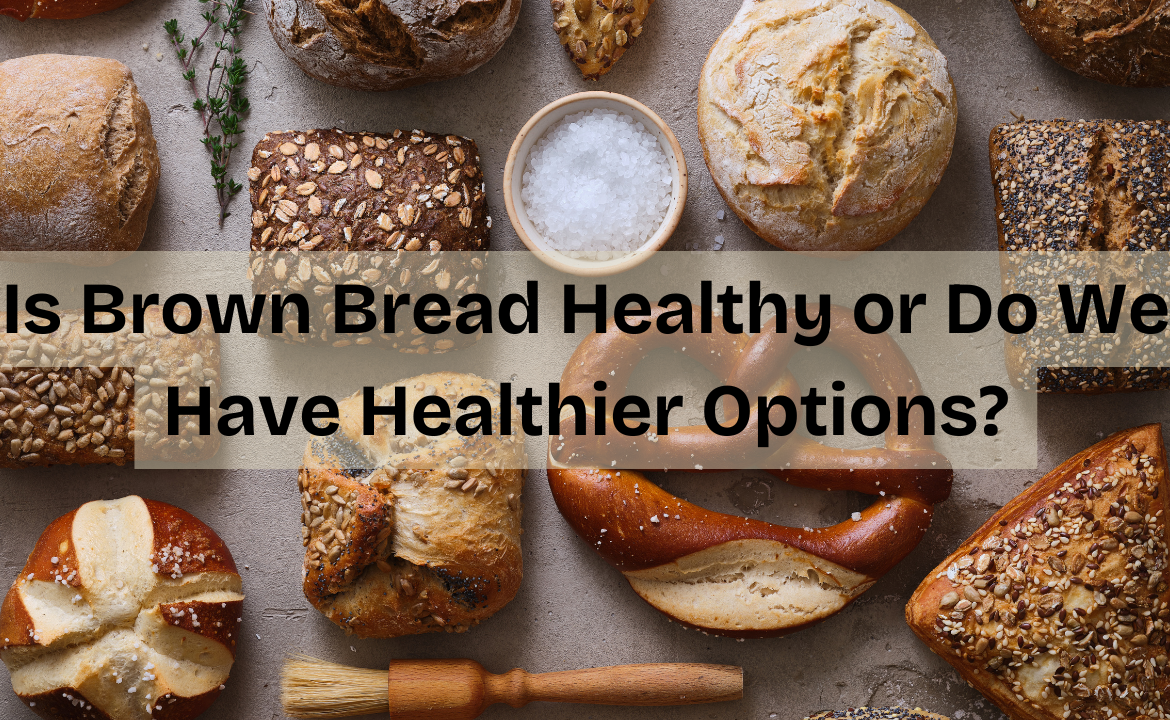Brown bread is probably the most famous bread that carries the “health halo.” It is usually marketed as a wholesome, nutrient-rich alternative to white bread. But is it really the healthier option, or are there other better choices out there?
In this blog, we’ll go deep into the nutritional profile of brown bread, debunk its health claims, and look at some healthier alternatives you might not be expecting. From weight loss and blood sugar control to eating cleaner, this guide will help you make informed choices about your daily bread.
1. What makes brown bread healthy?
Brown bread is healthier since it is prepared using whole grains that contain bran, germ, and endosperm. These have fiber, vitamins, and minerals. For instance, a slice of brown bread has 2-3 grams of fiber compared to less than 1 gram in white bread.
However, not all brown bread is equal. Some brands use caramel coloring to make them appear more whole grains and so are less nutritious than they say. Make sure it has “100% whole grain” or “whole wheat” as the first ingredient on the label.
2. Health Advantages of Brown Bread
Brown bread has several nutritional advantages:
- High in Fiber: Aids digestion, and you feel full for a longer time.
- Source of B Vitamins: It helps support energy metabolism.
- Contains Minerals: Iron, magnesium, and selenium are important for general health.
A 2016 study in the British Medical Journal reported that whole grains, such as those found in brown bread, have been shown to decrease the incidence of heart disease, stroke, and type 2 diabetes.
3. The Dark Side of Brown Bread: What You Should Know?
While brown bread is a good thing, it isn’t without flaws:
- Calorie-Dense: Depending on the type, some can be rather calorie-heavy; hence, one has to keep portions controlled.
- Sugar Content: Some brands include added sugar to sweeten the bread and raise blood sugar more.
- Gluten Content: Not gluten-free, making it unsuitable for individuals with gluten intolerance and celiac disease.
4. Alternatives to Brown Bread: Are They Really the Healthier Options?
Of course, brown bread is a significant step up compared to white, but there is actually an option even healthier. Let’s now see some of the best, what makes each special, and why they make more sense over your health objective. If your upgrade in game involves breads, consider some of these ones.
Sprouted Grain Bread
What makes it healthier: Made from whole grains that have begun to sprout, sprouted grain bread breaks down starches so that nutrients are readily available. Thus, this kind of bread is easier to digest and rich in more protein and fiber, and other essential nutrients.
Key Benefits:
- Higher in antioxidants, which fights inflammation.
- Has a lower glycemic index: For most people, it is better for blood sugar control.
- Enzymes help in breaking down the food properly.
- Best For: Those who want a nutrient-rich, easily digestible bread.
Rye Bread
Why It’s Healthier: Rye bread is made from rye flour, which is denser and richer in fiber than wheat flour. It has a lower glycemic index, meaning it releases sugar into the bloodstream more slowly, helping to stabilize energy levels.
Key Benefits:
- High in soluble fiber, which supports gut health and reduces cholesterol.
- Contains lignans, plant compounds associated with a lower risk of heart disease.
- Has a more prolonged feeling of fullness, which helps with weight control.
- Best For: Individuals with diabetes or wanting a heart-friendly choice.
Sourdough Bread
Why It’s healthier: Sourdough is naturally fermented using wild bacteria and yeast. This fermentation process makes it easier to digest by breaking down gluten and phytic acid, which promotes better nutrient absorption.
Key Benefits:
- Contains probiotics, thereby allowing probiotics to favour the gut.
- Rich in B vitamins and iron.
- Best For: Those with mild gluten sensitivities or anyone seeking better digestion.
Gluten-Free Bread
Why It’s healthier: A necessary staple for anyone with celiac disease or gluten intolerance, bread is a requirement. Not all gluten-free bread is healthy, though. Some brands use highly refined flours and added sugars. Instead, look for ones made with whole grains such as quinoa, buckwheat, or almond flour.
Key Benefits:
- Safe for those with gluten-related disorders.
- Often higher in protein and fiber when made with nutrient-dense flours.
- Can be lower in calories if made with simple ingredients.
- The Best For: Anyone who has celiac disease, is suffering from gluten intolerance, or avoids gluten for other reasons.
Seed-Loaded Whole Grain Bread
Why It’s better: Adding seeds to whole grain bread not only adds lots of nutrients, but also more healthy fats and protein. Magnesium and zinc are just a couple of the micronutrients that seeds contain.
Key Benefits:
- Omega-3 fatty acid content is high with flaxseeds and chia seeds. Omega-3s help keep your brain and heart healthy.
- Adds crunch and flavor, making it more satisfying.
- Increases fiber and protein content.
- Best For: Those looking for a nutrient-dense, flavorful bread option.
Oat Bread
Why It’s healthier: Oat bread is made from oats, a naturally gluten-free ingredient (cross-contamination does occur). Beta-glucan, a type of soluble fiber, is a major component in oats. These fibers support the heart and prevent spikes in blood sugar.
Key Benefits:
- Rich in beta-glucan that reduces cholesterol levels and promotes the health of gut.
- Provides sustained energy due to its slow-digesting carbs.
- Naturally sweet, reducing the need for added sugars.
- Best For: People focused on heart health or managing cholesterol levels.
Ezekiel Bread
Why It’s healthier: Ezekiel bread is one of those sprouted whole grain and legume-containing slices of bread, in it contains wheat, barley, lentils and soybeans. The combination of these ingredients yields a complete protein source-one that supplies all nine essential amino acids.
Key Benefits:
- High in protein and fiber, making it ridiculously filling.
- No added sugars or artificial ingredients.
- Rich in vitamins and minerals, including iron, magnesium, and B vitamins.
- Best For: Those looking for a high-protein, nutrient-dense bread option.
5. How to Choose the Healthiest Bread for Your Diet
Here’s a quick checklist:
- Look for 100% whole grain or whole wheat as the first ingredient.
- Avoid bread with added sugars or artificial preservatives.
- Choose bread with at least 3 grams of fiber per slice.
- Select options with fewer ingredients and no unrecognizable additives.
Conclusion:
Brown bread can be a healthy choice, but it is not the only option-or always the best one. Understanding its nutritional profile and exploring alternatives like sprouted grain or sourdough bread can help you make smarter choices that align with your health goals.
Remember, the healthiest bread is the one that fits your dietary needs and tastes great too. So, next time you’re at the grocery store, take a moment to read the label and choose wisely. Your body will thank you.
Also, see:
Weight Loss Snacks: 10 Nutritious Ideas
Topics #featured #Latest #Pakistan #trending pakistan




